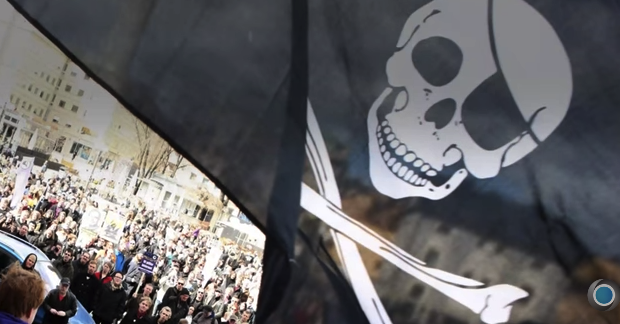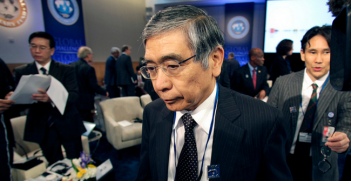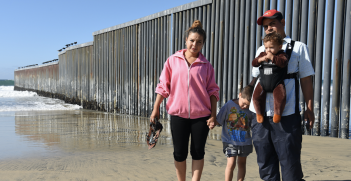Pirates and Political Fracturing in Iceland

On 29 October, Iceland will go to the polls. This year’s early vote takes place in the wake of an economic crisis that has stoked support for direct democracy and splintered the existing political structure. Up to 45 per cent of voters indicate they will support one of a host of new political groups, including the Pirate Party, and post-election negotiations to form any coalition government are expected to be difficult.
Before Iceland’s private banking sector crashed in 2008, the Icelandic political party system was rather stable. At its core were four parties: the right-of-centre Independence Party, the centrist Progressive Party, the Social Democratic Alliance and the Left-Green Movement. The combined votes of the four parties comprised more than 90 per cent of total votes cast between 1999 and 2013. Electoral turnout in parliamentary elections was always well over 80 per cent. However, the economic crisis and ensuing political developments undermined trust in the political system. The result has been increasing support for direct democracy and a reconfiguration of the party system.
The impact of the 2008 economic crisis on the party system did not became apparent right away. The four main parties still received more than 90 per cent of the votes in snap elections held in 2009. But votes shifted from the right to the left and the Social Democratic Alliance formed a coalition government with the Left-Green Movement under the premiership of Jóhanna Sigurðardóttir. It faced many challenges during its time in power. It lost two important referenda (on Icesave) that undermined its credibility, its austerity measures alienated its supporters, and it failed to push through reforms it had promised its voters. Moreover, the decision to apply for EU membership in 2009 caused internal divisions within the Left-Green Movement as until then it had vehemently opposed EU membership.
The unpopularity of the government resulted in huge electoral losses for the coalition’s individual parties in the 2013 parliamentary elections. The combined votes of the four traditional parties was reduced to 75 per cent. Moreover, there were 13 political parties on the ballot paper, a record number of contenders. Due to an electoral threshold of 5 per cent of votes, only six parties won parliamentary seats with 8.2 per cent supporting new centrist party, Bright Future and another 5.1 per cent voting for the unconventional Pirate Party. The remaining 12 per cent of votes were shared among the less successful parties. Electoral turnout had dropped from 85.1 per cent in 2009, to 81.5 per cent.
After the elections, the Progressive Party and the Independence Party formed a coalition government led by Sigmundur Davíð Gunnlaugsson. The economy had begun to improve and the new government set out to offer universal mortgage relief, lift capital controls and reach final settlements with the estates of the fallen banks. By the end of 2015 these goals had been mostly achieved. The economy was in a high growth phase, unemployment had dropped below 3 per cent, inflation was low and the currency reserves were considerable. Given these favourable economic conditions it may have been expected that voters would reward the coalition parties but polls showed that the Progressive Party had fallen out of favor.
Instead, at the start of 2016 support shifted to the Pirate Party from the Progressive Party, Bright Future and the Social Democratic Alliance. The Pirate Party advocates direct democracy and rejects internal party hierarchy, tapping into widespread sentiment favouring a shake-up of the political system. It has never been in government so it has not yet broken any electoral promises. The sudden popularity of the Pirate Party coincided with the controversial decision of Gunnlaugsson’s government to terminate Iceland’s application to the EU which left voters angry because they had been led to believe that a referendum would be held on the issue.
In April the political landscape changed dramaticallyy once more when Gunnlaugsson was forced to resign. The Panama Papers had revealed his wife owned an offshore company in a tax shelter. Furthermore, the couple had failed to disclose that the company had owned claims in the estates of the fallen banks with which the government had been negotiating during most of the term. Thousands of people took to the streets to demand for the Prime Minister´s resignation and early elections. It was declared that Sigurður Ingi Jóhannsson would take over as prime minister and the elections would be held six months early. At this time, support for the Pirate Party reached close to 40 per cent.
However, six months later and with less than three weeks until the elections, support for the Pirate Party has dropped to about 20 per cent. In comparison, the Independence Party enjoys about 25 per cent support. The Left-Green Movement comes in third with about 15 per cent support, whereas the Social Democratic Alliance and the Progressive Party both have less than 10 per cent support. This means that the combined vote for the traditional four parties has dropped from more than 90 per cent in 2013 to about 55 per cent today. Of the 12 political parties contesting the election only two other parties seem to have a change of winning parliamentary seats. They are the new centrist pro-business/EU party, Reconstruction, and Bright Future.
On this basis, there is only slim hope for a stable government after 29 Octobers and that hope will rely on skilful negotiations and lots of time.
Stefanía Óskarsdóttir is an associate professor at the University of Iceland. Her area of expertise is comparative politics with an emphasis on Icelandic politics. Stefanía was a member of Iceland’s Congress for the Independence Party, the Alþingi, in 2001, 2002 and 2003.
This article is published under a Creative Commons Licence and may be republished with attribution.





